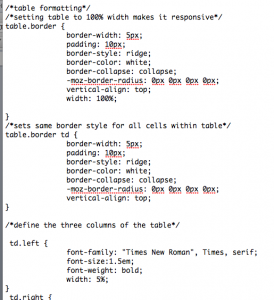 It’s taken years, but I’ve finally come around to cascading style sheets.
It’s taken years, but I’ve finally come around to cascading style sheets.
I was introduced to them in the absolutely worst way, when a Dreamweaver update suddenly refused to accept half the commands I was used to putting into my web pages. I couldn’t just make a word bold, I had to define bold in a different pane and then apply it to the word. Half the stuff I wanted could be coded through the html panel, and half through css. I had to search around to find a way to accomplish things that used to be simple.
Who were these invisible commisars interfering with my established dreamweavering? What was the point of defining bold, when I would have to do it all over again on the next page? Where were those definitions even stored? How were they related to templates, and why did my templates never apply to any of my pages anyway? I wrestled with all this for a few months, and then basically gave up using Dreamweaver.
My brother came to the rescue. He taught me what css was over Xmas vacation and showed me how to design my fiction website with it, coding in notepad. That was neat, but didn’t solve my larger problems – that the whole of my academic website, with hundreds of tutorial pages, had been made in Dreamweaver and now seemed impervious to any rational analysis.
Then this year, the light finally dawned. I can keep the site’s look stable by setting it up in css! I can keep the shared content for each tutorial — page titles and footers — in tutorial-specific css ‘after’ commands! (This is discouraged by css police, but I don’t care). I can keep commonly used hyperlinks in php files! I can call other people’s css files online (eg Bootstrap) and use their coding for tricky stuff like popovers! It’s become a game to see how much of a page’s content I can outsource to a css or php file. I can’t wait to start rewriting the site this summer.
Learning how to code isn’t my business, though. Teaching is my business. So what can I learn about teaching, or not teaching, from the fact that it took me six years to learn how to code in css in spite of the fact that I spent time coding in css during every one of those six years? Why did I not learn to do what I was learning to do?
After all, students do this all the time. They perform an analysis in the first hour of class and then look at you big-eyed, like so many plates of fried eggs, when you ask them to do it again in the second hour.
Here are some of the reasons that Dreamweaver failed to teach me about css.
- I already had a perfectly good way of doing what I wanted to do, and it introduced css as an impediment.
- It never explained what the css definitions were for — that what I defined on one page could be applied to any other pages. This isn’t uncommon. The folks writing documentation for such programs usually take the purpose of their procedures as given, never bothering to explain it to the lumpenusertariat.
- It solved a problem I didn’t know I had. It wasn’t until 4 years later when I got a wide monitor that I realized my web pages kept changing width, and that I needed to correct something on every single page.
- It did the interesting work for me. I couldn’t see the css file, where it was, what it was, or how to apply it to a page. I couldn’t tweak the css and see how it affected the page. I could just enter mysterious stuff into the black box and hope the gremlins inside would allow me to design a web page.
I applied some of these insights to my class on heart failure this week.
- Students already have a pretty reasonable understanding of heart failure, so why should I complicate it? Instead of my usual focus on distinguishing lots of different kinds of heart failure, I admitted that RHF and LHF would lead to one another. We defined those two types and how they led to congestive heart failure.
- I need to make clear what problem the new categories solve. Instead of introducing systolic and diastolic heart failure right away, as categories students need to understand for some unstated reason, I introduced them after CHF as ways to tell whether a patient will benefit from one treatment or another.
- Am I doing all the interesting work for them? Instead of telling students what murmur would be heard during what valve defect, I just gave them case studies — patient with CHF and preserved ejection fraction has diastolic murmur over mitral valve. What’s going on? Then I had them write their own case studies – choose a valve defect and predict what would happen with the patient. Next week we’ll work on the further consequences of the valve defects they chose, and flesh out those case studies.
I knew these were better instructional principles. We all know that. But we drift away from them, over and over again. That’s why faculty should, every now and then, try to learn something that challenges us from people who aren’t particularly good teachers — to remind ourselves of what we need to do and why we need to do it.
Otherwise we, like everybody else, fail to learn what we’ve been doing all along.








